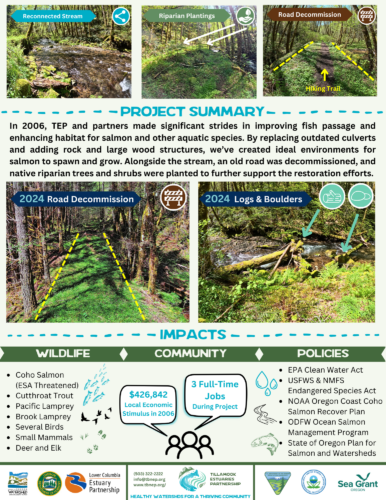Progress

- Pre-assessment (Completed)
- Project Design (Completed)
- Project Started (Completed)
- Project Finished (Completed)
- Monitoring Active (In Progress)
Partnership Success: Restoring Salmon Habitat in Cruiser Creek
In 2005, the Oregon Department of Forestry (ODF), Bureau of Land Management (BLM), and Tillamook Estuaries Partnership (TEP) initiated a ground-breaking salmon habitat enhancement project within the Tillamook Bay (Oregon) watershed. Straddling ODF and BLM land in the Cruiser Creek drainage, the project marked the first BLM-ODF restoration partnership within the region. Three Cruiser Creek tributaries had undersized, perched culverts blocking salmon migration. Several additional streams also limited salmonid production due to diminished instream complexity and poor wood recruitment potential. To address these issues, project partners replaced three culverts, enhanced 1 ½ miles of instream habitat, decommissioned 3.35 miles of forest roads, and planted five acres of riparian vegetation.
Post-project salmon rearing surveys revealed greater coho abundance than at any other location on the north Oregon coast. But the salmon numbers tell only a part of the story. The project, which received attention from a Portland news station, demonstrated the restoration potential that exists when the two agencies collaborate. By creating a new management model in which a third party (TEP) managed a project spanning their lands, ODF and BLM were better able to leverage the other’s financial and technical contributions to meet the project’s $200,000 price tag. In addition, TEP could ensure that the standards and practices unique to each landowner were fully met while reducing their administrative burdens. All project partners (and the coho!) look forward to future opportunities.
Project Details
Scroll Down for the 2024 Project update
Before and after large woody debris placement on Cruiser Creek


Large Woody Debris (LWD) placements play a key role in creating better habitat for salmon. By altering the river’s flow, LWD provides hiding spots and areas of slower-moving water where salmon can rest. These placements also help shade the water, keeping it cool, and serve as a home for macroinvertebrates—a favorite food of juvenile salmon.
Images by Russ

large Woody Debris Placement
Successful gravel accumulation and habitat development
One year after the project gravel accumulation could already be seen. Gravel is important for spawning salmon because they use it to create their redd (kind of like a nest) to lay their eggs. The image also shows great habitat for juvenile salmon in the formed pools.
Image By Oregon Department of Forestry
Before and after culvert replacement on Cruiser Creek


Culvert replacements are an important part of improving fish passage. Larger culverts that allow water to flow through them let salmon swim
Images by ODF
2024 Project Update: Lasting Impacts of Restoration in TIllamook’s Watersheds
TEP teamed up with Oregon Sea Grant to hire a Natural Resource Policy Fellow, Alyssa Purslow, to analyze the impacts of historic restoration projects on Tillamook County’s watersheds. Check out her 1-pager on Cruiser Creek.




